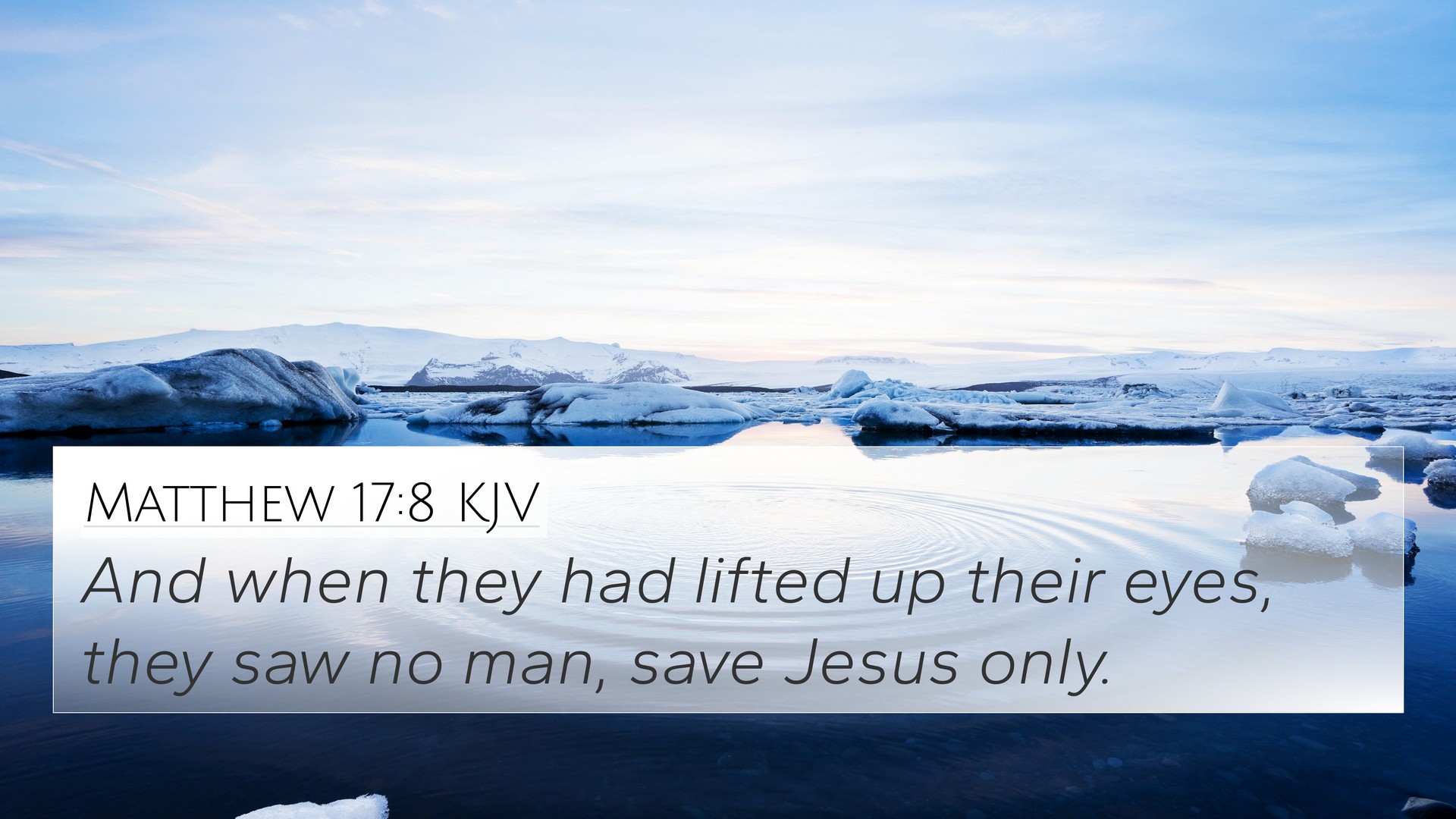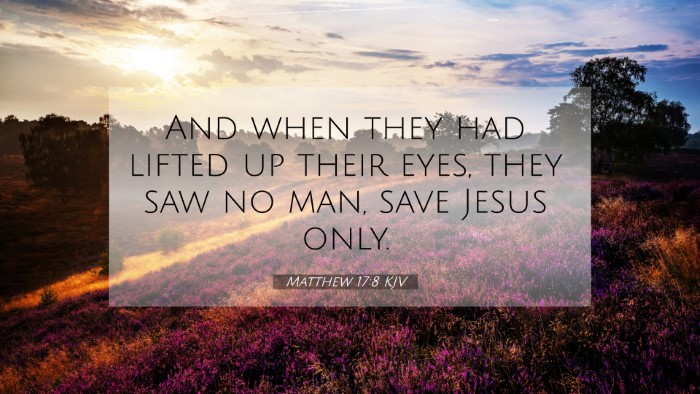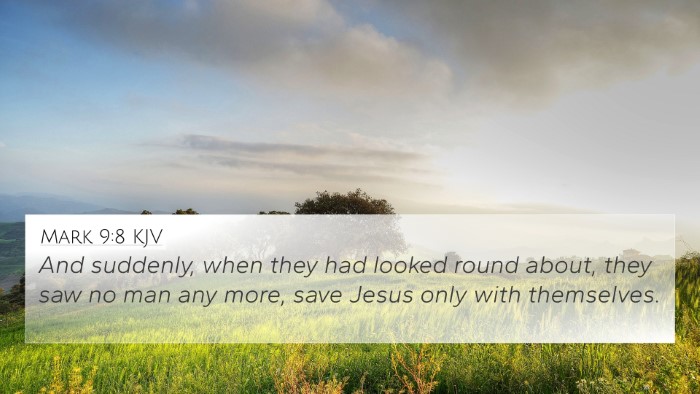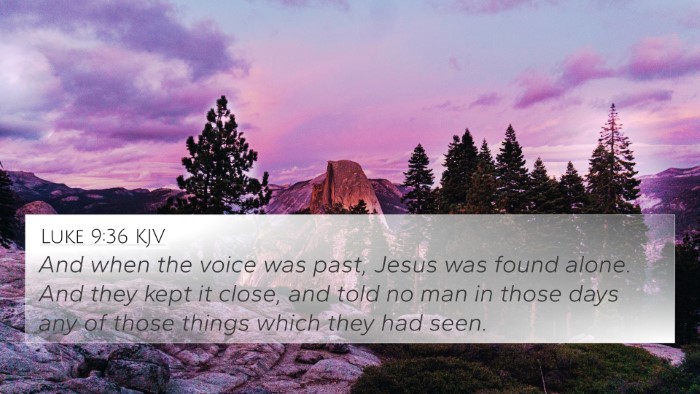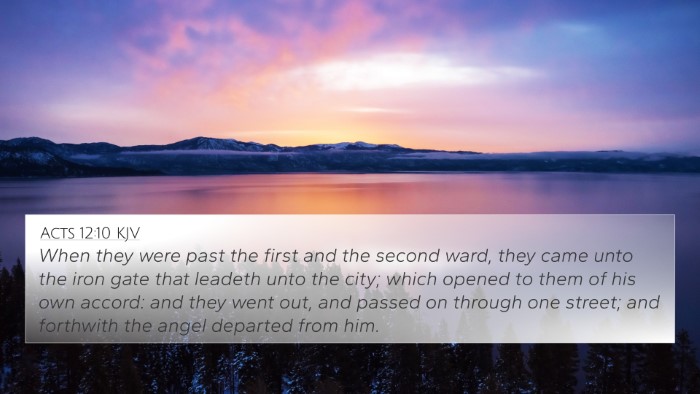Understanding Matthew 17:8
Verse Explanation: "And when they had lifted up their eyes, they saw no man, but Jesus only."
This verse concludes the remarkable transfiguration of Jesus where Peter, James, and John experience a divine manifestation of Christ's glory alongside Moses and Elijah. The significance of seeing "Jesus only" emphasizes His supremacy over the Law (Moses) and the Prophets (Elijah).
Commentary Insights
-
Matthew Henry's Commentary:
Henry portrays this moment as a powerful revelation. The disciples, initially overwhelmed by the glory witnessed, shift their focus solely to Jesus, which signifies His preeminence. The absence of Moses and Elijah underscores the idea that all attention should direct to Christ, the fulfillment of the Law and the Prophets.
-
Albert Barnes' Notes:
Barnes highlights the transformation of the disciples' understanding. After encountering the divine presence of Moses and Elijah, the sudden return to Jesus shows that in the end, He is the sole object of our faith and reverence, a truth that resonates throughout the New Testament.
-
Adam Clarke's Commentary:
Clarke expands on the amazement of the disciples, focusing on their need for revelation. Their experience reveals that direct communion with Christ is central to their spiritual journey, illustrating the importance of keeping our eyes fixed on Him amidst spiritual encounters.
Thematic Connections
This verse serves as a bridge to understanding various theological themes in the Bible, including the transition from the Old Covenant to the New Covenant. By focusing solely on Jesus, it emphasizes His role as the mediator and ultimate revelation of God.
Bible Verse Cross-References
To further enhance understanding, here are some Bible verses that relate to Matthew 17:8:
- Luke 9:36: "And when the voice was past, Jesus was found alone." - Similar to Matthew 17:8, focusing on Jesus alone.
- John 1:16-17: "And of his fulness have all we received, and grace for grace. For the law was given by Moses, but grace and truth came by Jesus Christ." - Jesus as the fulfillment of both grace and law.
- Hebrews 1:1-2: "God, who at sundry times and in divers manners spake in time past unto the fathers by the prophets, hath in these last days spoken unto us by his Son." - Declaring Christ, superior to former revelations.
- Exodus 34:29: "And it came to pass, when Moses came down from the mount, that Moses wist not that the skin of his face shone while he talked with him." - A reflection of God's glory shown in Moses, contrasted with the supreme glory of Christ.
- Matthew 28:18: "All power is given unto me in heaven and in earth." - Affirming Jesus' authority and preeminence recognized in Matthew 17:8.
- Colossians 1:17: "And he is before all things, and by him all things consist." - Emphasizing Jesus' eternal nature and centrality in creation.
- Revelation 22:4: "And they shall see his face; and his name shall be in their foreheads." - Pointing to the ultimate vision of Christ we are to have.
Connections Between Bible Verses
The act of Jesus remaining the sole focus is echoed through many scriptures, reinforcing the importance of Christ in both the apostolic teachings and prophetic discourse. The following aspects emerge through comparative Bible verse analysis:
- The Focus of Worship: Continuous emphasis in scripture that directs believers to worship God through Christ as the mediator.
- Prophets and Their Role: Acknowledgment of prophetic voices points to Jesus, particularly in New Testament references.
- The Superiority of Grace: Connection of Moses representing the Law and Jesus representing grace affirms the transformative power of the New Covenant.
Inter-Biblical Dialogue
This verse not only personalizes the revelation through Christ but also frames it within a broader inter-Biblical dialogue.
Tools for Bible Cross-Referencing
Engaging in cross-referencing can deepen understanding of these connections. Some useful tools include:
- Bible Concordance: To locate terms and themes across scriptures.
- Bible Cross-Reference Guide: Helps in identifying the relationship between verses.
- Bible Chain References: Systematic approach to linking themes.
Cross-Referencing Bible Study Methods
Utilizing cross-references provides insights for sermon preparation and personal study. Understanding similarities and differences between verses enables a richer comprehension of scriptural themes and narratives. It fosters a more cohesive understanding of the whole counsel of God.
Conclusion
In summary, Matthew 17:8 instructs us to focus on Jesus Christ, the culmination of divine and scriptural revelation. Reflection on this verse encourages believers to engage deeply with cross-referencing as a means to unravel the interconnectedness of God's Word. By exploring the links between various scriptures, one can appreciate the unified message of grace, truth, and the supremacy of Christ.
